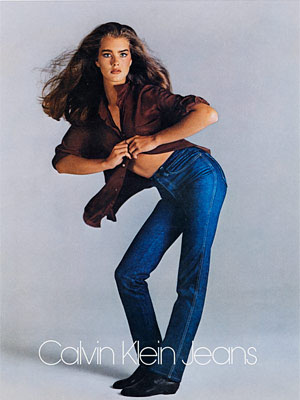 |
 |
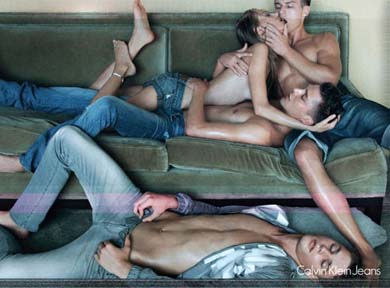 |
| Brooke Shields |
Figure 2c |
Figure 3b |
When it comes to how a consumer culture is influenced, it's safe to
stick with the old phrase "a picture is worth a thousand words" and these thousand words can affect
what society thinks. For example, when it came to the Brooke Shields ad, society immediately saw it
as "pedophilic obscenity" because of the fact that she was so young and because the ad gave "the
allusion to a panty-less Brooke, the idea of intimate contact between her private parts and a pair
of pants [...] was too much for some viewers" (Ivinski 109). After ads like this came out there were
many consumers that reacted in shocking and disgraced ways because of the context that cK had put
a woman's sexuality in. When asked about ads and objectification, Subject B talked about how she
felt women are "totally degraded" when it comes to ads (Interview 3). She uses the example of the
jean ad with the man and woman topless in a sexual position, Figure 2c. Subject B talks about how
Figure 2c could be degrading to a woman because "the woman is practically naked and being handled
by the man" (Interview 3). An advertisement like this is what leads to women feeling objectified
and stereotyped because, like Subject A states "woman are weak and can be shown to be more
vulnerable than men" (Interview 4). During the interview the question came up as to why women are
the only ones photographed half or completely naked. When a woman is undressed it gives a different
level of meaning than when a man is undressed, as Subject A discussed (Interview 4). Diana Crane
argues this idea by stating that, "media images of women are always directed at men and that women
are encouraged to look at themselves and other women the way men do" (Crane 314). Subject A touches
on this idea when he discusses how when a guy flips through a magazine he's going to be more
attracted to stop and look at an ad if it has a really attractive woman on the page - most likely
the women will be undressed in some way (Interview 2). This idea in which producers "incorporating
masculine standards for female appearance that emphasizes physical attributes and sexuality [is
known as hegemonic femininity]" (Crane 314). When producers place a woman, like the one from
Figure 3b with the two men touching all over her, in a "sexualized and demeaning pose" they are
demonstrating this hegemonic femininity (Crane 314). Feminists continue to argue how this hegemonic
femininity influences the way society continues to see women. Women have always had to fight for
their voice, whether it was the right to vote or the right to choose to be pregnant, women have
always been placed in an inferior position to men. This idea can be seen multiple times in
advertisements and because of that hegemony finds it difficult to break that idea.
An important concept that plays a part in how hegemonic femininity
works is with its relationship with the "male gaze". The "male gaze" is the concept in which the
perspective of an image is intended to be portrayed in a male-subject point-of-view (Rose 121).
Anytime a print image is geared toward the male consumer it can be said to contain this
"male gaze". With images like that from Figure 3b, the gaze would have to be that of a male's
because of the sexual handling the males in the ad are subjecting the female to. Just by looking
at an ad like that the consumer could interpret it as saying that "if you buy these jeans you'll
get sex" (Interview 2). Using images with women being "handled" by men, cK continued with the
idea of "pushing the bounds of acceptability in advertising" (Dooley 96).
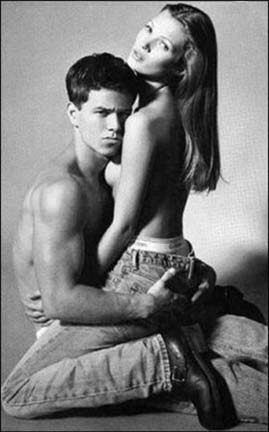 |
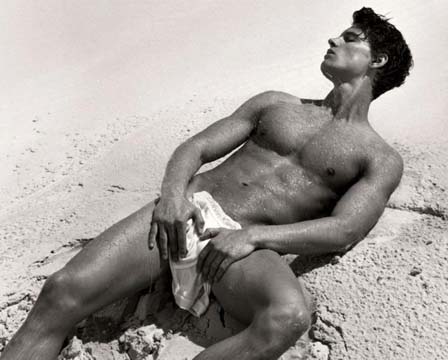 |
 |
 |
| Figure 3a |
Figure 4a |
Figure 4b |
Figure 4c |
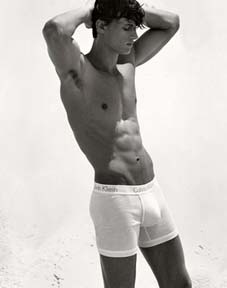 |
 |
 |
| Figure 4e |
Figure 4f |
Figure 8a |
Just because men are said to be stronger doesn't mean that they too
are never made the focus of an advertisement. In the 1990s, cK chose to use Mark Wahlberg as a
face for the brand. In figure 3a, he is depicted with Kate Moss. The interview group labeled this
image as "less emotion" than the more racy images within the category (Interview 4). This image was just the
beginning for Mark Wahlberg. Later, he would join other male models in the classic underwear ads
that cK is known for. In Figure 8a, Wahlberg is show in nothing but tight, white boxer briefs.
Then in Figures 4a-f, a male model is pictured in what could be said to be tiny underwear. Figures
like these are seen throughout magazines and can have a mixed belief of whether it is
objectification or not. Subject A and B both answered that this image was not an objectification
but instead Subject A discussed how Figures 4a-f and 8a could show a man being comfortable with
himself enough to wear close to anything. While Subject C disagreed and discussed how he didn't see
the purpose in depicting the men like that. Because of this disagreement, it can be said that
society would also find it confusing whether to prove if a male can find the same level of
objectification as a female in advertisement or if males in advertisement open up a different
level of interpretation all together. Katherine Frith describes this new level as being
"a [perpetuation] of stereotypes, [a play on] our fears of not being socially acceptable [...]"
(Frith 1). Regardless of whether a man is or isn't being stereotyped or objectified, the
advertisement can still bring in the idea of male insecurities or acceptance. The meaning of an
advertisement will continue to hold possible interpretations but one of the strongest ways to see
a meaning is to look at an ad through a semiotic approach and use signs to gain a better
interpretation.
Print Me Calvin Klein |
cK Says "Show Me Quality" |
Just Think cK |
Flash...Snap...Sex |
What's Your Culture Kingdom? |
Who Owns You? |












